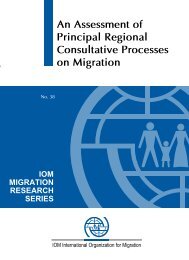A Global Compact on Learning - Brookings Institution
A Global Compact on Learning - Brookings Institution
A Global Compact on Learning - Brookings Institution
Create successful ePaper yourself
Turn your PDF publications into a flip-book with our unique Google optimized e-Paper software.
• Strategy 3B: Ensure that post-primary educati<strong>on</strong><br />
prepares young people for healthy lives,<br />
productive work, and civic participati<strong>on</strong>.<br />
This chapter c<strong>on</strong>siders the acti<strong>on</strong>s needed to pursue<br />
each of these strategies.<br />
Figure 4.1. Strategies and Acti<strong>on</strong>s to Support Postprimary Educati<strong>on</strong> Opportunities<br />
Priority 3: Support transiti<strong>on</strong>ing to and completing sec<strong>on</strong>dary school and other post-primary<br />
opportunities that build relevant life and labor skills.<br />
Overview<br />
More young people must be<br />
supported to transiti<strong>on</strong> to<br />
post-primary educati<strong>on</strong> while<br />
simultaneously addressing serious<br />
c<strong>on</strong>cerns about the applicability,<br />
or relevance, of what they learn<br />
to their lives and livelihoods.<br />
Ensuring a larger number of young<br />
people receive a quality sec<strong>on</strong>dary<br />
educati<strong>on</strong> requires that they<br />
complete a primary educati<strong>on</strong> of<br />
good quality, reducing demand- and<br />
supply-side barriers, and improving<br />
the relevance of educati<strong>on</strong> so that<br />
young people are prepared for local<br />
work opportunities and to make a<br />
healthy transiti<strong>on</strong> to adulthood. We<br />
need to build <strong>on</strong> less<strong>on</strong>s learned<br />
and take successful interventi<strong>on</strong>s<br />
to scale. Additi<strong>on</strong>ally, alternative,<br />
n<strong>on</strong>-formal models that utilize<br />
innovative modes of delivery are<br />
needed, many of which require<br />
more rigorous evaluati<strong>on</strong>s.<br />
Strategies<br />
Reduce barriers that<br />
prevent girls and boys<br />
from transiti<strong>on</strong>ing to<br />
sec<strong>on</strong>dary school and<br />
other post-primary<br />
educati<strong>on</strong>al opportunities<br />
Ensure that post-primary<br />
educati<strong>on</strong> prepares young<br />
people for healthy lives,<br />
productive work, and<br />
civic participati<strong>on</strong><br />
Acti<strong>on</strong>s<br />
• Provide well-targeted, appropriately<br />
structured subsidies for educati<strong>on</strong>ally<br />
marginalized groups<br />
• Provide a safe envir<strong>on</strong>ment and girlfriendly<br />
school policies<br />
• Build social support structures to<br />
encourage <strong>on</strong>going learning for girls<br />
and boys<br />
• offer sec<strong>on</strong>d-chance learning<br />
opportunities<br />
• Provide flexible post-primary models<br />
utilizing innovative modes of delivery,<br />
including technology<br />
• Strengthen the link between postprimary<br />
educati<strong>on</strong> and improved life and<br />
labor opportunities<br />
• Teach transferable skills, such as<br />
critical thinking and informati<strong>on</strong> and<br />
communicati<strong>on</strong> technologies (ICT)<br />
• Facilitate school-to-work and school-tolifel<strong>on</strong>g<br />
learning transiti<strong>on</strong>s<br />
Box 4.1. Ensuring More Girls Receive a Quality Post-Primary Educati<strong>on</strong><br />
Many adolescent girls in low-income countries<br />
are not making the transiti<strong>on</strong> to sec<strong>on</strong>dary school,<br />
despite clear evidence of the large social and ec<strong>on</strong>omic<br />
benefits—including improved health, delay<br />
of early marriage and pregnancy, increased wages<br />
and ec<strong>on</strong>omic growth, and an enhanced role in decisi<strong>on</strong>s<br />
that affect their lives. N<strong>on</strong>-formal post-primary<br />
programs, which are often the most appropriate<br />
opti<strong>on</strong> for adolescent girls who have missed<br />
out <strong>on</strong> years of school, must be linked to the formal<br />
educati<strong>on</strong> system, provide clear pathways back to<br />
school or work, and offer recognized credentials.<br />
Post-primary educati<strong>on</strong> should be flexible in delivery<br />
to accommodate girls’ work and domestic<br />
resp<strong>on</strong>sibilities. Post-primary educati<strong>on</strong> should<br />
teach a range of academic and transferable skills—<br />
such as critical thinking, communicati<strong>on</strong>s, and<br />
financial literacy—that prepare girls for healthy<br />
transiti<strong>on</strong>s to work, marriage, motherhood, and<br />
civic participati<strong>on</strong>.<br />
A <str<strong>on</strong>g>Global</str<strong>on</strong>g> Compa c t <strong>on</strong> <strong>Learning</strong>: Taking Acti<strong>on</strong> <strong>on</strong> Educat i o n in Developing Countries<br />
C e n t e r for Universal Educat i o n at <strong>Brookings</strong><br />
31






